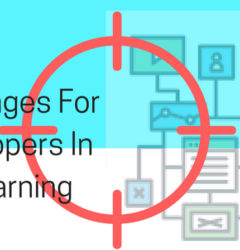Into the e-Learning world with Erich Renken
20 Feb

We talked to Erich Renken, an instructional designer at United Educators about how he got into instructional design, his team, his approach to designing courses, and how he keeps up with the latest trends & technology.
What made you an instructional designer?
Like so many of my colleagues, it was more of an accident than an intentional career path. As I was nearing the end of my English degree in 1996, I wasn’t certain what my first job would be. As luck would have it, my roommate had found work at a small company that was creating CD-based training. I applied for a job as an “instructional designer” and began by writing the storyboards for instructor-led training that was being converted to CD-based asynchronous training.
How is your team set up at United Educators?
We have a small, but growing, team of seven on our Learning Design team. We have a manager, three IDs, two visual designers, and one front-end developer.
This has changed since I began here three years ago. Back then, it was a manager, one other ID, and the front-end developer. We all developed our own programs independent of each other. Although every one of us had some experience designing and developing visual assets, it still meant that the visual treatment was often lackluster.

Now we’ve changed to a more component-oriented model where one ID writes the content of the course, they collaborate with another designer to develop the course, and the visual elements are created by our visual designers. Because everyone’s now focused on their strengths, the quality of our courseware has improved dramatically.
How does the team communicate with each other and the clients?
With the change in course development, we also adopted several agile techniques learned from Michael Allen’s “Leaving ADDIE for SAM” book. We kick off each project with our version of a “savvy start” and have daily scrums to ensure we’re all moving in the same direction.
Our courses are products and so our clients are internally based. We use Zipboard to create weekly iterations of our product. Even if this wasn’t an interview for Zipboard, I’d say that it’s a great tool for helping us to identify and log issues within the course. We used to send around a Word template for capturing issues and this invariably led to problems as some reviewers weren’t able to share screen captures. We also needed to merge all of these Word documents into a master list of issues. Zipboard makes it much easier for reviewers to capture issues and for our Learning Design team to fix the issues and track their status.
Can you share what’s your typical design and development process?
We begin with a multi-day “savvy start” to identify all of the subject matter that we want to address. We also begin putting together some rough prototypes to build consensus on the approach we’re considering.
After that, we go into the storyboard phase during which some prototyping continues. Once our storyboards are approved, we start building the course shell and developing the video assets.
Once the course is completed and approved by our stakeholders, we use an outsourced QA team to review the course before we load it into our LMS.
How do you use zipBoard as part of your process?
As I mentioned earlier, we use Zipboard for weekly “builds” of our course. Not every reviewer looks at each build of the course, but we’ve found that a weekly cadence is often enough to allow us to address changes before we’re too far along in the development process
How do you manage your projects and tasks during development?
We’ve evaluated several online project management tools, but using spreadsheets in Sharepoint has met most of our development tracking needs. With that said, we’re also using Zipboard and JIRA to help us track issues.
We conduct weekly project meetings in addition to the aforementioned daily scrums to report our progress to internal stakeholders.
What are the most important things you can share about instructional design?
My credo has always been to design training that I would enjoy taking. Consider the learner. Consider the time that they’re investing in your course and be respectful of that.
As an ID, you’re usually trying to improve a learner’s knowledge, skills, or attitude. For example, if I’m designing training for a new software system, I want to give learners a safe environment in which they can practice their tasks so they don’t cause real problems in a production environment. Make your mistakes when the stakes are low. I find this kind of procedurally-based skill-building the easiest to develop. It can also be fun to emulate the actual system and challenging because the actual system is usually changing right up to the minute it’s released.
Trying to change someone’s attitude, on the other hand, can be much more challenging. For example, I’m currently working on a course that addresses sexual assault on college campuses. One of the learning objectives is related to improving bystander intervention (when a third party intervenes in a situation that appears to be escalating towards sexual harassment, sexual assault, or intimate partner violence). How do you change someone’s attitude from that of, “This isn’t any of my business” to “What can I do to stop this?” Well, you can equip them with strategies (skills), the data related to sexual assault (knowledge), but changing an attitude often involves appealing to a learner’s emotions and this can be difficult to do in the span of a course.

In short, an ID is often called on to be a good storyteller, audio/video production expert, and designer of courses that will work in a variety of LMSs. (It can be hard work keeping a learner engaged in a subject as mundane as workplace harassment.) There are good tools out there that help us build the course files. If you take courses, you should definitely check out the new Articulate set of tools. The Adapt Framework is also a great open source project for building responsive courses.
How do you hire people in your team?
Carefully. A bad hire can have such deleterious effects on a team. We generally post jobs to task-specific job boards as well as some of the larger job boards.
How do you keep up with the latest in the technology and e-learning world?
My RSS feed grows every year and I generally spend about 30 minutes each morning reading blog posts as I find this practice to be an invaluable source of information.
Conferences are generally good, but I often find the sessions to be more rudimentary than I’d like.
I’m currently working on a computer science degree from Georgia Tech and I’ve had one of the best experiences of my career working as a teaching assistant in the EdTech class. EdTech is growing by leaps and bounds and it can be easy to feel overwhelmed or wonder where to start. If you’re new to the field, I’d say The eLearning Guild is a good place to start.
What would be your advice to aspiring instructional designers?
Read “e-Learning and the Science of Instruction: Proven Guidelines for Consumers and Designers of Multimedia Learning” by Ruth Clark and Richard Mayer.
Something I find myself doing is watching people learn. Having a 20-month-old is a great crash course on how we, as humans, learn. Build learning in such a way that learners can make mistakes and then fix those mistakes. It’s tougher to build courses like that, but it’s an invaluable part of the learning process.
Which are the tools you cannot live without as an instructional designer?
For me, the Adobe Creative Cloud suite is a must-have. We’re also using two-course authoring tools at the moment, the Adapt Builder and Storyline 360.
A good collaboration tool is essential when communicating with team members.
Don’t forget a good tool, like Zipboard, to help manage the relationship between developers and stakeholders.
Catch up with Erich on Linkedin for more updates from him.
Request Demo
Request a personalized demo of zipBoard to add team members as collaborators, share feedback, iterate over multiple versions - the tool to make e-Learning courses better and faster.
Get DemoRelated Post
Recent Posts
- Best Practices for Efficient Document Reviews and Collaboration December 18, 2025
- MEP Document Management: How to Streamline Reviews & Avoid Rework October 3, 2025
- What Is Online Proofing Software? And Why Content Review Breaks Without It July 11, 2025
- How Laerdal Medical Cut eLearning Review Time by 50% with zipBoard’s Visual Review Tool July 9, 2025
- Why Your Team Needs a Content Feedback System (Not Just Comments in Docs) May 28, 2025
©️ Copyright 2025 zipBoard Tech. All rights reserved.

